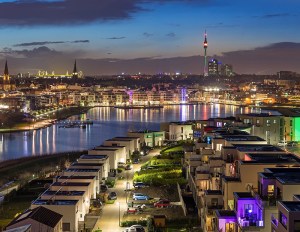Phoenix: The Epicenter of the New West Coast
CRG’s Mark Sonnenberg discusses Phoenix’s potential to become the new gateway market for industrial tenants.
After partnering with CRG through Bird Dog Industrial for the development of The Cubes at Glendale, a 335-acre industrial park in Glendale, Ariz., Mark Sonnenberg joined CRG’s new Phoenix office. In his position as senior vice president & partner, Sonnenberg signed on to lead the firm’s regional industrial investment activities.
He brings more than 20 years of experience to the new role at CRG, the real estate development arm of Clayco. Sonnenberg is the founder of Bird Dog Industrial and has completed more than 1,000 industrial real estate projects in 41 U.S. states, nine Canadian provinces and five Mexican states.
In a discussion with Commercial Property Executive, Sonnenberg talks about his new role and what’s behind the growth of Phoenix’s industrial market. He also sheds light on why Phoenix is a strategic player in the emergence of the New West Coast and what sets it apart from other major U.S. industrial markets.
How do Bird Dog’s and CRG’s philosophy of developing industrial facilities align?
Sonnenberg: CRG and BDI were both looking for a large flagship industrial development opportunity in Phoenix’s West Valley. BDI needed a national partner with the balance sheet and in-house capabilities for acquiring a large multiphase development site, and CRG needed a boots-on-the-ground partner with market knowledge and relationships. It was a perfect match.
In April, you joined CRG to lead the firm’s regional office as senior vice president & partner. What are your priorities in your new role at CRG?
Sonnenberg: One of the main reasons I joined CRG is to scale quickly and efficiently during this hot development cycle. Initially, we are focused on acquiring a second large industrial development position in the Southeast Valley to compliment The Cubes at Glendale in the West Valley, providing us with flagship development sites in the Phoenix metro area. Additionally, we are completing market due diligence and pursuing new development sites throughout the Southwest Region including Las Vegas, Reno, Salt Lake City and Denver.
Can you outline the key points of CRG’s industrial investment strategies for 2021?
Sonnenberg: Our focus for industrial is finding strategic development opportunities for modern industrial assets across core logistics markets throughout the U.S. Phoenix is a priority for that strategy due to the market’s rapid growth in both distribution and manufacturing.
You mentioned that you consider Phoenix as a strategic player in the emergence of the New West Coast. Why is that?
Sonnenberg: California will always have a huge population base and be a leader in global business and trade on the West Coast, but, as we’ve experienced over the last decade, affordability, opportunity and regulation are becoming major issues for both the people and the industry.
Metro areas bordering California like Phoenix, Las Vegas and Reno are benefitting from in-bound migration due to their proximity to the West Coast but offering a higher quality of life.
This includes a lower cost of living, reasonable taxation and regulation practices, diversified career opportunities and abundant recreational opportunities due to a warmer climate. Phoenix’s growing population and strategic location in the Southwest make it the epicenter of the New West Coast movement.
READ ALSO: Can Phoenix Become America’s Semiconductor Capital?
Phoenix is deemed to become the new gateway market for industrial tenants. How does the metro compare to other top industrial markets such as the Inland Empire?
Sonnenberg: The Inland Empire will always play a strategic role in global trade given its proximity to the ports of LA and Long Beach. But one of the areas we are seeing Phoenix differentiate itself from the Inland Empire is in the manufacturing sector. The amount of large-scale manufacturing prospects considering the Phoenix market is impressive.
Are there any challenges that might slow down Phoenix’s industrial expansion?
Sonnenberg: Phoenix has a long runway for expansion and no major challenges in the foreseeable future, but eventually, factors will arise that could slow its growth.
Where does Phoenix need to improve to live up to its potential?
Sonnenberg: The Phoenix metro area and the state of Arizona just need to keep doing what already works: low regulation, moderate taxation and being open to growth and diversification.
What are some of the key trends that drive industrial activity in Phoenix?
Sonnenberg: Key trends driving industrial activity include supply and demand imbalance due to production slowdowns during the pandemic; users needing larger warehouses for e-commerce, last-mile delivery and on-hand inventory, and demand is strongest for modern Class A warehouses.









You must be logged in to post a comment.